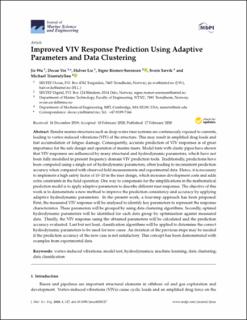| dc.description.abstract | Slender marine structures such as deep-water riser systems are continuously exposed to currents, leading to vortex-induced vibrations (VIV) of the structure. This may result in amplified drag loads and fast accumulation of fatigue damage. Consequently, accurate prediction of VIV responses is of great importance for the safe design and operation of marine risers. Model tests with elastic pipes have shown that VIV responses are influenced by many structural and hydrodynamic parameters, which have not been fully modelled in present frequency domain VIV prediction tools. Traditionally, predictions have been computed using a single set of hydrodynamic parameters, often leading to inconsistent prediction accuracy when compared with observed field measurements and experimental data. Hence, it is necessary to implement a high safety factor of 10–20 in the riser design, which increases development costs and adds extra constraints in the field operation. One way to compensate for the simplifications in the mathematical prediction model is to apply adaptive parameters to describe different riser responses. The objective of this work is to demonstrate a new method to improve the prediction consistency and accuracy by applying adaptive hydrodynamic parameters. In the present work, a four-step approach has been proposed: First, the measured VIV response will be analysed to identify key parameters to represent the response characteristics. These parameters will be grouped by using data clustering algorithms. Secondly, optimal hydrodynamic parameters will be identified for each data group by optimisation against measured data. Thirdly, the VIV response using the obtained parameters will be calculated and the prediction accuracy evaluated. Last but not least, classification algorithms will be applied to determine the correct hydrodynamic parameters to be used for new cases. An iteration of the previous steps may be needed if the prediction accuracy of the new case is not satisfactory. This concept has been demonstrated with examples from experimental data. View Full-Text | en_US |

